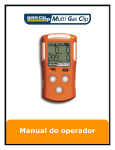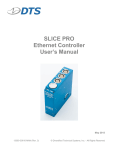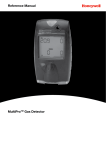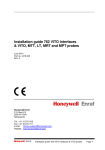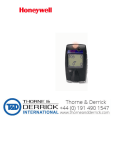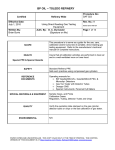Download Honeywell IQ Force Multigas Detector Safe
Transcript
Safe Operation Manual Honeywell IQ Force™ Gas Detector Honeywell Analytics 800-663-4164 403-248-9226 Fax 403-575-3708 03JUN2012 P/N 50105843-047 Version 01 http://www.honeywell.com HONEYWELL IQ Force PERSONAL PORTABLE GAS DETECTORS HAVE BEEN DESIGNED FOR THE DETECTION AND MEASUREMENT OF POTENTIALLY HAZARDOUS ATMOSPHERIC CONDITIONS IN ORDER TO ASSURE THAT THE USER IS PROPERLY WARNED OF POTENTIALLY DANGEROUS ATMOSPHERIC CONDITIONS, IT IS ESSENTIAL THAT THE INSTRUCTIONS IN THIS MANUAL BE READ, FULLY UNDERSTOOD, AND FOLLOWED. Honeywell IQ Force Safe Operation Manual Part Number 50105843-047 Version 01 Copyright © 2012 by Honeywell Analytics All rights reserved. No page or part of this operation manual may be reproduced in any form without written permission of the copyright owner shown above. Honeywell Analytics reserves the right to correct typographical errors. Table of Contents CERTIFICATION INFORMATION SIGNAL WORDS OPERATING TEMPERATURE WARNINGS AND CAUTIONS 1. DESCRIPTION 1.1 Methods of sampling 1.2 Optional sample-draw pump 1.2.1 Special precautions when using the motorized pump 1.3 Manual sample-draw kit 1.3.1 Manual sample-draw kit usage 2. CALIBRATION 3. MAINTENANCE 3.1 Li-Ion batteries 3.1.1 Li-Ion Battery charging guidelines APPENDIX A: CALIBRATION FREQUENCY RECOMMENDATION APPENDIX B: TOXIC SENSOR CROSS-SENSITIVITY APPENDIX C: SPECIFICATIONS III III III III 1 1 2 2 2 2 3 3 3 3 4 5 5 Certification Information UL Class I, Division 1, Groups A,B,C,D Temp Code T4 UL Class II, Division 1, Groups F,G UL Class III CSA Class I Division 1 Groups A,B,C,D Temp Code T4 Exia ATEX Certification: II 2 G Ex d ia IIC T4 Gb DEMKO 12 ATEX 1103746X IECEx Certification: Ex d ia IIC T4 Gb IECEx UL 12.0014X Signal Words The following signal words, as defined by ANSI Z535.4-1998, are used in the Honeywell IQ Force Safe Operation Manual. indicates an imminently hazardous situation which, if not avoided, will result in death or serious injury. indicates a potentially hazardous situation which, if not avoided, could result in death or serious injury. indicates a potentially hazardous situation, which if not avoided, may result in moderate or minor injury. CAUTION used without the safety alert symbol indicates a potentially hazardous situation which, if not avoided, may result in property damage. Operating Temperature The Honeywell IQ Force’s operating temperature range is printed on the label on the back of the instrument. Use of the IQ Force outside of its specified operating temperature range may result in inaccurate and potentially dangerous readings. Warnings and Cautions 1. The Honeywell IQ Force personal, portable gas detector has been designed for the detection of dangerous atmospheric conditions. An alarm condition indicates the presence of a potentially life-threatening hazard and should be taken very seriously. 2. In the event of an alarm condition it is important to follow established procedures. The safest course of action is to immediately leave the affected area, and to return only after further testing determines that the area is once again safe for entry. Failure to immediately leave the area may result in serious injury or death. 3. Do not use the Honeywell IQ Force with any sample draw pump other than the appropriate IQ Force pump (54-69-102) supplied with the instrument. 4. Do not charge the Honeywell IQ Force with any charger other than the appropriate IQ Force charger (54-69-103) supplied with the instrument. 5. To reduce the risk of explosion, recharge the batteries outside of the hazardous location. 6. The Honeywell IQ Force contains a Lithium-Ion battery. This battery is not replaceable by the user. In the event that the battery becomes unusable, the instrument must be returned to Honeywell and the battery and associated parts replaced as an assembly. 7. The accuracy of the Honeywell IQ Force should be checked periodically with known concentration calibration gas. Failure to check accuracy can lead to inaccurate and potentially dangerous readings. (The Canadian Standards Association (CSA) requires an accuracy check using known concentration calibration gas prior to each day’s use.) 8. Fresh air/zero calibrations may only be performed in an atmosphere that is known to contain 20.9% oxygen, 0.0% LEL and 0 ppm toxic gas. 9. The accuracy of the Honeywell IQ Force should be checked immediately following any known exposure to contaminants by testing with known concentration test gas before further use. Failure to check accuracy can lead to inaccurate and potentially dangerous readings. 10. The accuracy of the Honeywell IQ Force should be checked immediately following any physical shock. Failure to check accuracy can lead to inaccurate and potentially dangerous readings. 11. A sensor that cannot be calibrated or is found to be out of tolerance should be replaced immediately. An instrument that fails calibration may not be used until testing with known concentration test gas determines that accuracy has been restored, and the instrument is once again fit for use. 12. Do not reset the calibration gas concentration unless you are using a calibration gas concentration that differs from the one that is normally supplied by Honeywell for use in calibrating the IQ Force. Customers are strongly urged to use only Honeywell calibration materials when calibrating the IQ Force. Honeywell offers calibration kits and long-lasting cylinders of test gas specifically developed for easy IQ Force calibration. Use of non-standard calibration gas and/or calibration kit components can lead to dangerously inaccurate readings and may void the standard Sperian Instrumentation warranty. Substitution of components may impair intrinsic safety. 13. 14. For safety reasons this equipment must be operated and serviced by qualified personnel only. Read and understand this Safe Operation manual and the user manual before operating or servicing the IQ Force. 15. A rapid up-scale reading followed by a declining or erratic reading may indicate a hazardous combustible gas concentration that exceeds the IQ Force’s zero to 100 percent LEL detection range. 16. The IQ Force is not designed for use in oxygen-enriched atmospheres. 17. Do not use a motorized sample-draw pump with the IQ Force for prolonged periods in an atmosphere containing a concentration of solvent or fuel that may be greater than 10% LEL. 18. To prevent ignition of flammable or combustible atmospheres, do not open the IQ Force’s housing when an explosive atmosphere is present. 1. operation monitors only the atmosphere that immediately surrounds the detector. The IQ Force can also be used to sample remote locations with the hand-aspirated sample-draw kit or with a motorized continuous sample-draw pump (both available separately). During remote sampling, the gas sample is drawn into the sensor compartment through the probe assembly and a length of tubing. Remote sampling operations monitor only the atmosphere at the end of the sample-draw probe. Use of the hand-aspirated sample-draw kit and the motorized sample-draw pump is covered in the User Manual. Note: It is necessary to verify the accuracy of the IQ Force by calibration with known concentration test gas whenever a change is made to the sensors installed in the instrument. Calibration procedures are discussed in detail in the User Manual. Description The Honeywell Analytics IQ Force is a multisensor gas detector that can be configured to meet a wide variety of user requirements. This section provides an overview of many of the features of the IQ Force. More detailed descriptions of the specific features of the IQ Force are contained in the User Manual. A sensor that cannot be calibrated or is found to be out of tolerance must be replaced immediately. An instrument that fails calibration may not be used until testing with known concentration test gas determines that accuracy has been restored, and the instrument is once again fit for use. Read and understand this manual and the User Manual before using the IQ Force. 1.1 Methods of sampling The IQ Force may be used in either diffusion or sample-draw mode. In either mode, the gas sample must reach the sensors for the instrument to register a gas reading. The sensors are located at the bottom of the instrument. There are three distinct sensor ports that allow the sample to reach the individual sensors. The sensor ports must be kept free of obstruction. Blocked sensor ports can lead to inaccurate and potentially dangerous readings. In diffusion mode, the atmosphere being measured reaches the sensors by diffusing through the vents at the bottom of the instrument. Normal air movements are enough to carry the sample to the sensors. The sensors react quickly to changes in the concentrations of the gases being measured. Diffusion-style Honeywell IQ Force portable gas detectors have been designed for the detection of deficiencies of oxygen, accumulations of flammable gases and vapors, and accumulations of specific toxic gases. An alarm condition indicating the presence of one or more of these potentially life-threatening hazards should be taken very seriously. In the event of an alarm condition, it is important to follow established procedures. The safest course of action is to immediately leave the affected area, and to return only after further testing determines that the area is once again safe for entry. Failure to immediately leave the area may result in serious injury or death. 1 A rapid up-scale reading followed by a declining or erratic reading may indicate a hazardous combustible gas concentration that exceeds the IQ Force’s zero to 100 percent LEL detection range. or until readings stabilize. For example, with 10 feet of tubing, it will be necessary to allow a minimum of 55 seconds for the sample to be drawn into the sensor chamber and for the readings to stabilize. 1.2 Do not use the pump for prolonged periods in an atmosphere containing a concentration of solvent or fuel that may be greater than 10% LEL. Optional sample-draw pump A motorized sample-draw pump is available for the IQ Force for situations requiring continuous “hands free” remote monitoring. 1.3 Manual sample-draw kit The manual sample-draw kit is composed of a sample-draw probe, three sections of tubing, a squeeze bulb, and an adapter that is used to connect the sample-draw accessories system to the Honeywell IQ Force. Note: The maximum amount of tubing that can be used with the manual sample-draw kit is 50 feet. Use only IQ Force sample-draw pump part number 54-69-102 with the IQ Force. The pump contains a circuit that detects restrictions in airflow caused by water or other obstructions being drawn into the unit and immediately acts to turn the pump off in order to protect the sensors, pump, and other IQ Force components from damage. 1.3.1 Manual sample-draw kit usage To use the manual sample-draw kit: 1. Secure the sample-draw assembly to the IQ Force with the integral thumbscrew. 2. To test the seals in the sample-draw system, first cover the end of the sampledraw probe with a finger, then squeeze the aspirator bulb. If there are no leaks in the sample-draw kit components, the bulb should stay deflated for a few seconds. 1.2.1 Special precautions when using the motorized pump The internal material used in the pump diaphragm seal is susceptible to temporary compromise by high levels of combustible fuels and solvents. If the pump is being used in an atmosphere that may contain concentrations of combustible fuels and solvents that exceed 10% LEL, test the pump frequently to ensure that the seals have not been compromised. To test the pump, block the sample inlet with a finger. The pump should go into alarm. If the pump fails to go into alarm while the inlet is blocked, the pump is not working properly and the IQ Force may not be providing accurate readings. If the pump test fails, the safest course of action is to immediately leave the affected area, and return only after further testing determines that the area is once again safe for entry. 3. Insert the end of the sample probe into the location to be sampled. 4. Squeeze the aspirator bulb to draw the sample from the remote location to the sensor compartment. To ensure accurate readings while using the manual sample-draw kit, it is necessary to squeeze the bulb once for every one foot of sampling hose for the sample to first reach the sensors, and then to continue squeezing the bulb once per second for an additional 45 seconds or until readings stabilize. For Please refer to the User Manual for further instructions and safety precautions regarding the proper use of the pump. Note: The maximum amount of tubing that can be used with the motorized sampledraw pump is 50 feet. To ensure accurate readings while using the continuous sample pump, it is necessary to allow the pump to draw the sample for one second for every one foot of sampling hose plus an additional 45 seconds 2 example, if 10 feet of tubing is used, it will be necessary to draw the sample in by squeezing the bulb repeatedly for a minimum of 55 seconds or until readings stabilize. IQ Force must be performed while located in a non-hazardous location. Maintenance of the IQ Force in a hazardous location may impair intrinsic safety. 5. Note the gas measurement readings. When replacing the LEL sensor use only Honeywell part number 54-49-80C. See user manual for sensor replacement procedure. CAUTION: Hand-aspirated remote sampling only provides continuous gas readings for the area in which the probe is located while the bulb is being repeatedly squeezed. Each time a reading is desired, it is necessary to squeeze the bulb a sufficient number of times to bring a fresh sample to the sensor compartment. Use only IQ Force charger part number 54-69-103 with the IQ Force. 3.1 2. Calibration The accuracy of the IQ Force should be verified on a regular basis. Verification can be as simple as performing a bump test, which is described in the User Manual. 3.1.1 Li-Ion Battery charging guidelines The Li-Ion battery in the IQ Force should never be charged at temperatures lower than 5°C/40°F or higher than 30°C/86°F. Charging at temperature extremes can permanently damage the IQ Force Li-Ion battery. The Canadian Standards Association (CSA) requires the LEL sensor to be bump tested prior to each day’s use with calibration gas containing between 25% and 50% LEL. To prevent ignition of flammable or combustible atmospheres, the IQ Force must be located in a nonhazardous location during the charging cycle. The IQ Force’s battery charger is not approved for use in hazardous locations. The Canadian Standards Association (CSA) requires the instrument to undergo calibration when the displayed LEL value during a bump test fails to fall between 100% and 120% of the expected value for the gas. 3. Li-Ion batteries The IQ Force is powered by a Li-Ion rechargeable battery. See the User Manual for specific instructions concerning the storage and maintenance of Li-Ion batteries. Do not charge the IQ Force with any charger other than the appropriate IQ Force charger, supplied with the instrument. See the User Manual for replacement chargers. Maintenance Sensor replacement and any other maintenance operations on the 3 Appendix A: Calibration Frequency Recommendation Sensor Reliability and Accuracy Today’s sensors are designed to provide years of reliable service. However, there are a number of reasons a sensor may unexpectedly lose additional sensitivity or even fail to respond to gas. Such reasons include desiccation, poisoning, physical restriction of airflow, over exposure, internal leakage, or mechanical damage due to physical shock and immersion. Verification of Accuracy With so many reasons why a sensor can lose sensitivity and given the fact that dependable sensors are critical to survival in a hazardous environment, frequent verification of sensor performance is paramount. There is only one sure way to verify that a sensor can respond to the gas for which it is designed. That is to expose it to a known concentration of target gas and compare the reading with the concentration of the gas to ensure that it is within a manufacturer's recommended tolerable limits. This is referred to as a "calibration check" or “bump” test. This test is very simple and takes only a few seconds to accomplish. The safest course of action is to do a calibration check or bump test prior to each day’s use*. It is not necessary to perform a full calibration (adjustment) unless readings for LEL and toxic gases/vapors are outside of the range of 90% to 120% of the expected value. For oxygen, the acceptable range is considered to be ±0.5% vol., so 20.4% to 21.4% O2 in ambient clean air or via application of zero air. Further for oxygen, for application of Honeywell Analytics 18.0% O2 balance gases, the reading should again be within ±0.5% vol., so 17.5% to 18.5% O2. * The Canadian Standards Association (CSA) requires the LEL sensor to be checked prior to each day’s use with calibration gas containing between 25% and 50% LEL. ** The Canadian Standards Association (CSA) requires the instrument to undergo calibration when the displayed LEL value during a bump test fails to fall between 100% and 120% of the expected value for the gas. Lengthening the Intervals between Verification of Accuracy The IQ Force is shipped with a default calibration interval of 30 days. The 30-day calibration interval provides the IQ Management software with multiple sensor sensitivity data points required for effective predictive maintenance features. If you are not using the predictive maintenance features in IQ Management system, or do not wish to calibrate your detector as often, Honeywell Analytics recommends the detector be calibrated at least once every 180 days. 4 Honeywell Analytics recommends a daily bump test to ensure that the instrument is in proper working order. One-Button Automatic Full Calibration and calibration Docks While it is only necessary to do a “bump” test to ensure that the sensors are working properly, all current Honeywell/Sperian and Honeywell Analytics gas detectors offer a one-button auto full calibration feature. This feature allows you to do a full calibration of a gas detector in about the same time as it takes to complete a calibration check or bump test. The use of calibration docks can further simplify the tasks, while automatically maintaining records of sensor performance. Please read also the application note: 13-366 “Use of ‘equivalent’ calibration gas mixtures.” This application note provides procedures to ensure safe calibration of LEL sensors that are subject to poisoning. Honeywell Analytics' website is at: www.honeywellanalytics.com A complete list of accessories compatible with the IQ Force gas detector can be found there. Appendix B: Toxic Sensor Cross-Sensitivity The table below provides the cross-sensitivity response of the IQ Force toxic gas sensors to common interference gases. The values are expressed as a percentage of the primary sensitivity, or the reading of the sensor when exposed to 100ppm of the interfering gas at 20ºC. These values are approximate. The actual values depend on the age and condition of the sensor. Sensors should always be calibrated to the primary gas type. Cross-sensitive gases should not be used as sensor calibration surrogates without the express written consent of Sperian Instrumentation. SENSOR CO H2S SO2 NO NO2 Cl2 ClO2 Carbon Monoxide (CO) 100 <1 <1 5 <1 -1 -3 Carbon Monoxide (CO-H) 100 <1 <1 <1 <1 <1 Hydrogen Sulfide (H2S) <2 100 <10 <4 -20 -25 H2 HCN HCl NH3 C2H4 C2H2 50 15 3 0 25 250 N/D 5 <1 N/D 0 <30 100 -50 <1 N/D N/D <1 <1 N/D Appendix C: Specifications Detector dimensions: 4.75" (12 cm) x 3.25" (8.3 cm) x 2" (5.1 cm) Weight: 12.8 ounces (363 g) Operating temperature range: -20 °C to +50 °C (-4 °F to +122 °F) Battery charging temperature range: +5 °C to +30 °C (+40 °F to +86 °F) Storage temperature: -20°C to +50°C (-4°F to +122°F) Operating humidity: 20% to 90% RH continuous, 0% to 95% RH intermittent Dust and moisture ingress: IP 67 (instrument), IP65 (pump) Detection ranges: Carbon Monoxide: 0 to 999 ppm Hydrogen Sulfide: 0 to 200 ppm Oxygen: 0 to 30.0% vol. Combustible Gas: 0 to 100% LEL, 0 to 5% CH4 Audible alarm: 92 dB at 30 cm Visual alarm: Red LED visible from front, top and sides Display: Multi-row LCD Backlight: Automatic in alarm conditions and upon keypress, color is alarm-dependent Self-test: Initiated at activation Calibration: Manual and automated via docking station Nominal voltage: 4.2 volts Warranty: 2 years (monitor), 1 or 2 years (sensors, depending on type) 5











